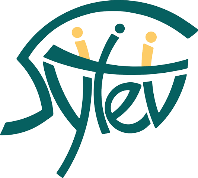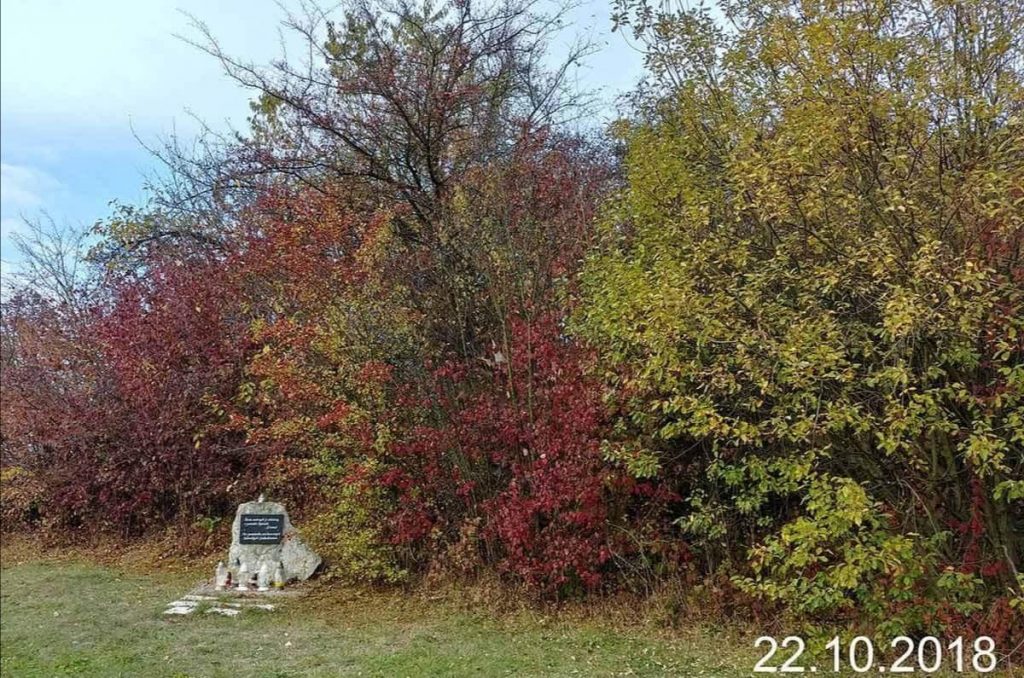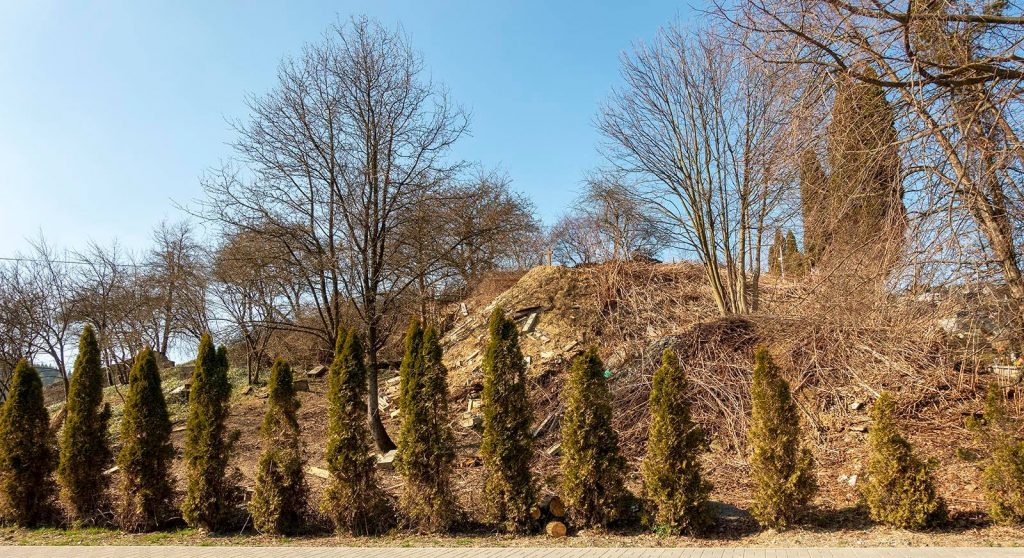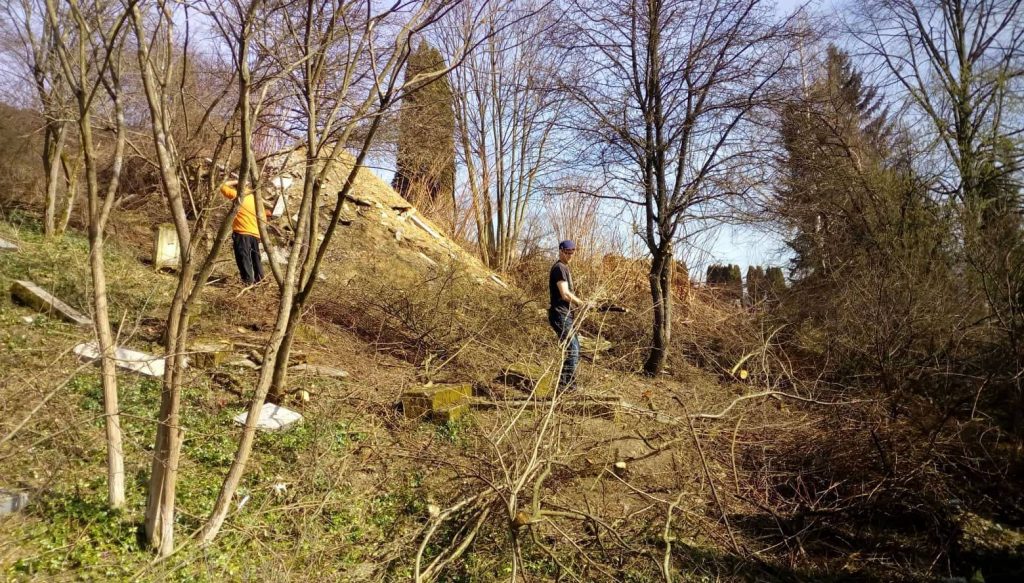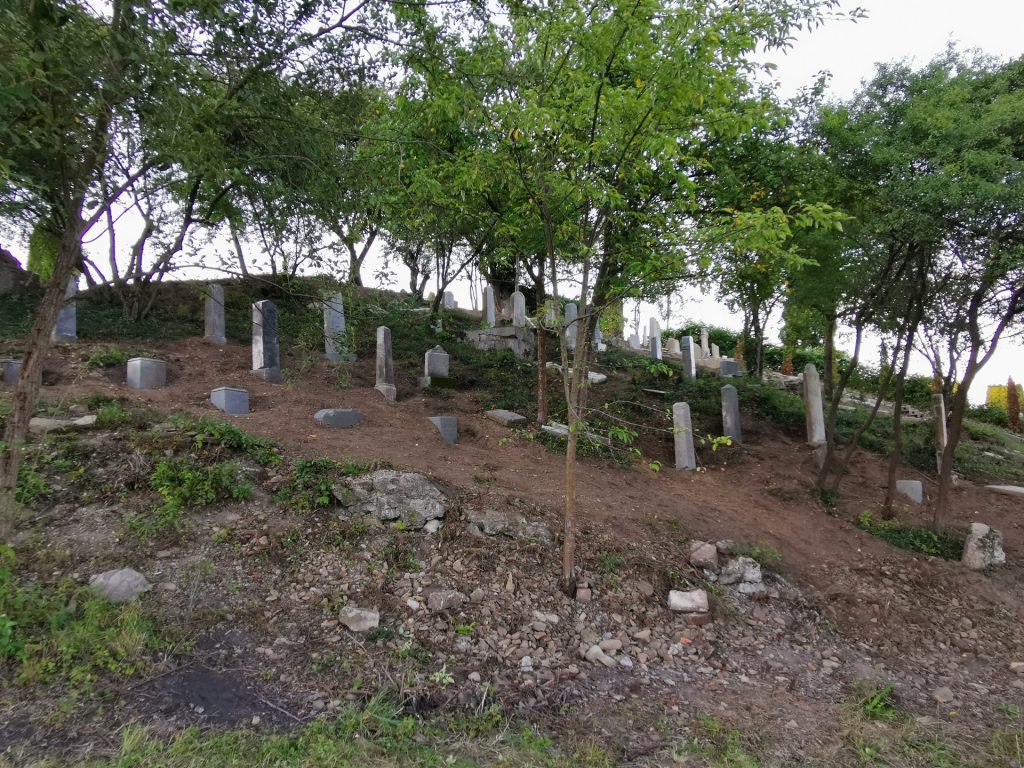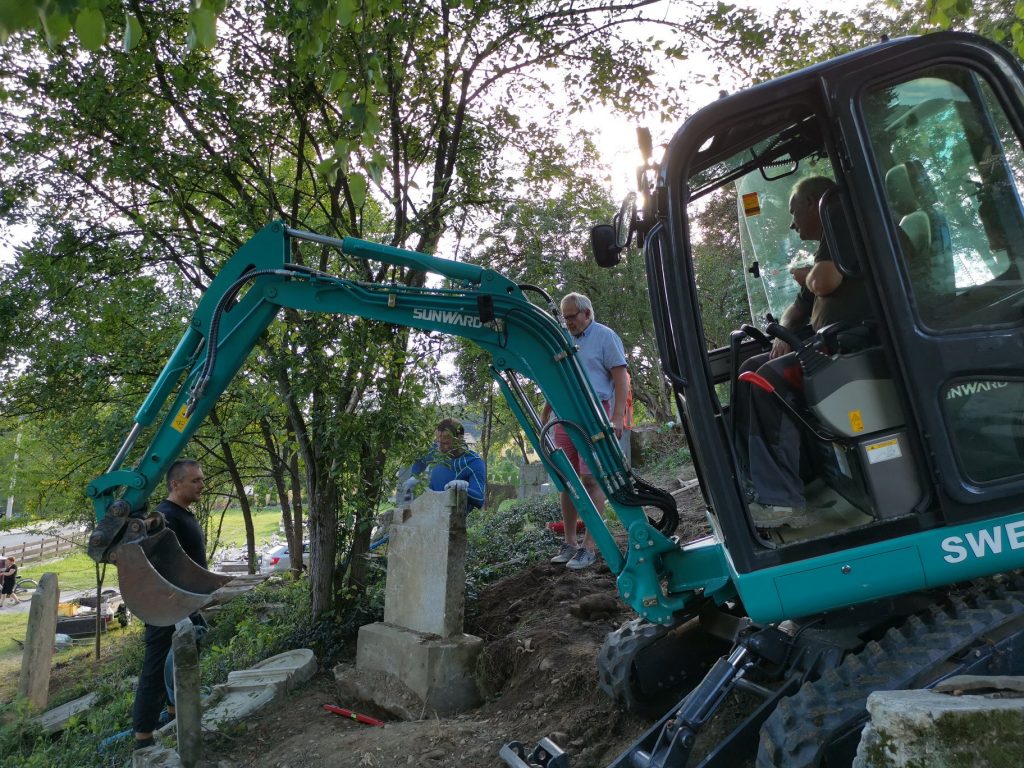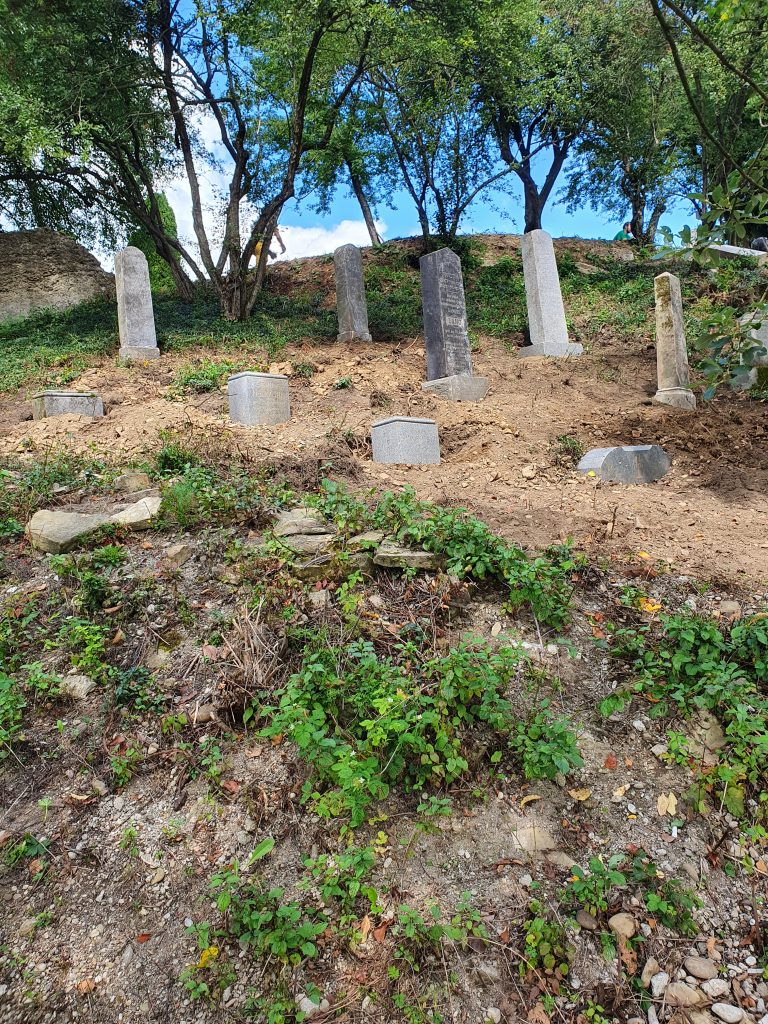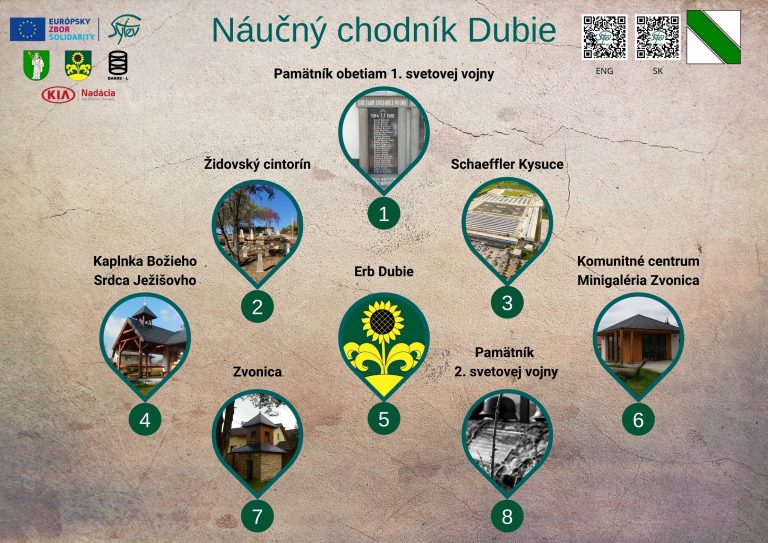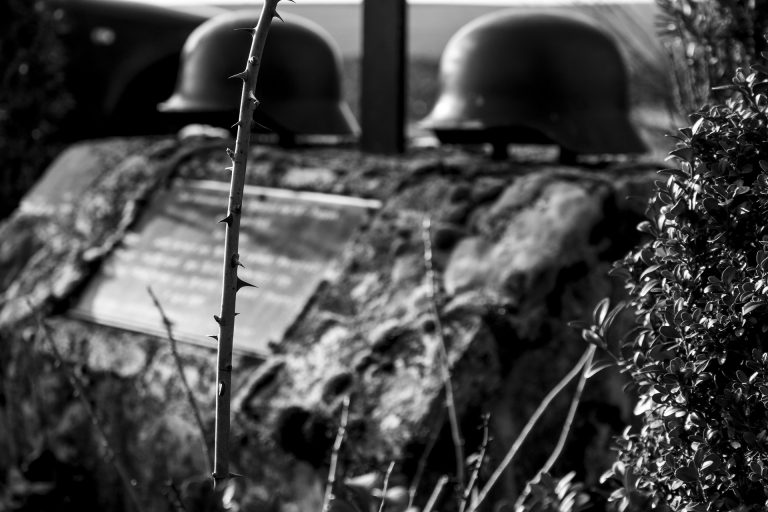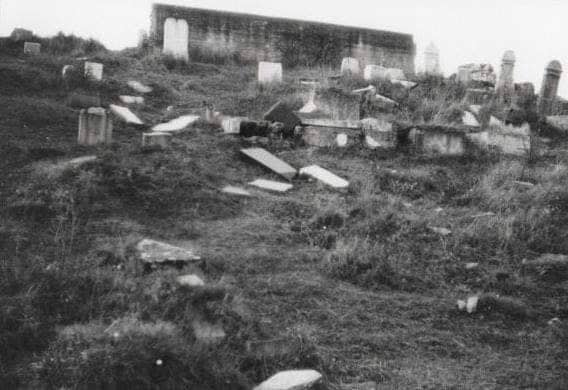
The Jewish cemetery in Kysucké Nové Mesto was established in the second half of the 19th century and is located on the outskirts of the town, which was based on the position of Jews in society at that time. It is the only historical monument in our city to the Jewish community. Jews from our city but also the surrounding villages were buried here. There are tombstones from the second half of the 19th century, on one excavated there is even a symbol of God’s crown. It can be a tombstone of a rabbi or an expert on the Torah. On some of them, we can see the skillful work of stonemasons of that time, so we can also talk about them as works of art. This cemetery is an integral part of the history of our city. After the war, no one cared about the cemetery and the Jewish community was never rebuilt. After many years, over the time it has become an illegal landfill. The current situation was due to local activists and volunteers who worked together to revitalize this historical and cultural monument.
DEMISE OF THE JEWISH COMMUNITY IN KYSUCKÉ NOVÉ MESTO
Kysucké Nové Mesto has stood in history, but even today, in the shadow of its older brother – the city of Žilina. It was the same with his Jewish community, which was much less numerous than the one in Žilina. Nevertheless, as in other cities, it has left its significant historical footprint. The establishment of the independent Slovak Republic in 1939 marked the beginning of the end of this social cell, which culminated in the spring of 1942. The end of the Jews in Kysucké Nové Mesto was even frighteningly fast for Slovak conditions. In these conditions, we can speak of a definitive solution, since after the war, none of the Jews of Oskon, New Town returned, and the community was never restored.
JEWISH COMMUNITY IN KYSUCKÉ NOVÉ MESTO UNITIL 1939
In the context of the Kysuce area, we can date the arrival of Jews to the period of the second quarter of the 18th century, when mainly resettlers from Bohemia and Moravia began to settle here. The phenomenon of Jewish immigration to the western part of Hungary was sketched by Peter and Pavel Frankls who state that it was mainly due to anti-Jewish measures during the reign of Charles VI. (1711 to 1740) in the countries of the Habsburg Monarchy outside Hungary. In particular, it was a translocation rescript, which again ordered the closure of Jewish communities to ghettos, and a family law regulating the number of Jewish families, with the result that only the eldest son could marry and start a family in each family. In addition, the Hungarian nobility supported the arrival of the Jews and their capital, and they were able to find a more lively environment for life and work and business activities. The first mention of a settler of Jewish origin in the immediate vicinity of Kysucké Nové Mesto was made by Antónia Hudecová, when in 1767 she mentions tailor and innkeeper Adam Marek in Dolný Vadičov. In the following years, a community began to form in the Bystrická valley. Around 1781, Solomon’s innkeeper joined his wife, Judith, his son – businessman Marek Šalamún and his daughter Rozália in Horný Vadičov and Aron Marek in Prostredný Vadičov. Kysucké Nové Mesto itself had a different development compared to other territories, especially in the upper and middle Kysuce, and the Jewish community did not begin to form here until a century later.
The first entry in the register of the Kysucké Nové Mesto rabbinate dates from 1876. In this year, 10 children were born and there were also 2 marriages. However, there is also an older record, specifically from 1874, where, however, are not given specific names, but only the number of issued birth letters – 12, death letters – 3 and 3 marriage letters. It follows from the above that in this period the Jewish community had to function and develop here for some time. If we take into account the most important demographic data, namely the number of children born the rabbinate of the Kysucké Nové Mesto experienced the greatest boom in the 80s and first half of the 90s of the 19th century, when the number of newborns regularly exceeded 10, in some years even 20, in 1885 even 30. From 1896 to 1905, when the records in the registry expire, in only one case was the number of newborns higher than 10. In addition to the town itself, the rabbinate of Kysucké Nové Mesto also included the villages of Budatín, Divina (listed in the register as Nagy Divina), Divinka (Kis Divina), Dubie (Dubje), Dolný Vadičov (Vadicsó), Horný Vadičov (Felsö Vadicsó, Ober Vadicsó), Krásno nad Kysucou (Krásna), Kotrčina Lúčka (Kotrs. Lucka), Kysucký Lieskovec (Ljeskowetz), Lutiše (Lutis), Lalinok (Lalinek), Nesluša (Neslus), Ochodnica (Ochodnitz), Oškerda, Považský Chlmec (Chlumecz), Povina , Radoľa, Rudinka (Klein Rudinka), Rudinská, Vranie (Vranje) Zástranie (Zasztranya) and Zborov nad Bystricou. Budatínska Lehota, Lopušná, Pažite, Prostredný Vadičov and Rudina do not mention any of the municipalities that should logically fit into this district, probably due to the absence of the Jewish ethnic group or no registration was made in the monitored period. In 1900, 109 inhabitants of the Jewish faith were reported in Kysucké Nové Mesto alone. During the first Czechoslovak republic it was really problematic to define territory of rabbinate in Kysucké Nové Mesto. In 1928, at the request of the District Chief Aurel Rutšek, statements by notaries from the district notary offices of the Kysucké Nové Mesto district on the affiliation of individual municipalities to the rabbinate districts were delivered to the District Office in Kysucké Nové Mesto. Statement of the District office in Povina: „I announce that in this district, just in Lieskovec (municipality) lives jewish families named Weichherz“. This families belongs to the rabbinate in Žilina. In district Nesluša report says, that is no Jewish persons, if they are, they will belongs to the rabbinate in Kysucké Nové Mesto. Municipalities Starý Bystrica, Klubina and Radôstka are in the one united Jewish community and until the 28. of October 1918 they had own rabbinate, they are not part of any other rabbinate. Krásno nad Kysucou connected administration from local Jew Jozef Brichta who says:
“ …previously Čadca, now Kysucké Nové Mesto, there is Tax office and also Registry“. It follows from the above that in this period the rabbinate in Kysucké Nové Mesto functioned only de jure, but de facto the Jewish inhabitants of the individual municipalities used the rabbinates according to their needs and discretion. Recognition of the rabbinate in Kysucké Nové Mestoby fellow believers can also be problematic. In 1929, a note was sent from the district office in Kysucké Nové Mesto to the Regional Office in Bratislava, worded as follows: Report by Rabbi in Kysucké Nové Mesto: Jozef Schlänger Goverment regulation No. 124/1928 does not have tha right for congru by §3, because he did not prove: Citizenship, study in grammar school. His testimony about education, there is lack of credibility because it certificate comes from Hungry and its not legalised and not proving education in § 14. As the nominee has died, no further replenishment can be requested.
The Jews were initially engaged in trade, hospitality and inn activities. Gradually, however, they penetrated into higher social spheres. In this direction, the golden era could be called the period of the first Czechoslovakia (1918 – 1938). Many have achieved academic education. In the district of Kysucké Nové Mesto there were several Jewish doctors, all of them mentioned by MUDr. Arpád Polláček, lawyer JUDr. Karol Neumann etc. Jews were also active in regional politics during this period. From 1924, Nathan Neumann was a full member of the municipal council, and in 1926, Jozef Szüsz was an alternate member. There were several companies operating in the city, e.g. A. Windholz, Bartolomej Scheer or Gross a Ring from Žilina, or domestic Artur Salzer and Hermann Schlänger, Adolf Braun, etc., in addition to them, there are also a number of self-employed people. However, the social rise of the Jews and their successful entrepreneurial activities brought with them a wave of anti-Semitism. The negative attitude towards the Jewish ethnic group among the citizens of the Christian majority in the 19th and 20th centuries is generally known and persists in various forms to this day. Dlhomír Poľský, a great one in his poems Židák baša (1895) or V Židových pazúroch (1896), is also critical of their entrepreneurial ferocity, harshness, liberalism, but also usury, or unfair business practices. For spiritual purposes, the Jewish community built a synagogue. The original building burned down in a devastating fire in Kysucké Nové Mesto on August 16.-17., 1904. The new synagogue stood on today’s Pivovarská Street and was demolished in 1972. The Jewish cemetery was outside the city to the west on today’s Dubská drive. Jewish inhabitants of the town and surrounding villages have been buried here since the beginning of the 19th century.
RESOLVING THE JEWISH QUESTION DURING THE FIRST SLOVAK REPUBLIC
The establishment of an independent Slovak state on March 14, 1939 brought Hlinka’s Slovak People’s Party to the pinnacle of power, whose representatives introduced a tough anti-Jewish policy. They supported their authoritarian regime by exploiting anti-Semitic sentiments in society. In the territory of the Slovak Republic, several laws and regulations were gradually adopted, which created a special legal regime for Jews.
1.) Government Regulation No. 63 on April 18, 1939 on the definition of the concept of Jew and the guideline of the number of Jews in certain occupations.
2.) Government Regulation No. 150 on June 21, 1939 on the regulation of military duty for Jews.
3.) Government Regulation No. 184 on July 25, 1939 on the regulation of the number of Jews in the practice of medical practice.
4.) Constitutional Act No. 185 on July 21, 1939 on the Constitution of the Slovak Republic.
5.) Government Regulation No. 230 on September 19, 1939 on the regulation of the military duty of the Jews.
6.) Regulation with the power of Act No. 7 on January 11, 1940 amending the Government Decree on the Exclusion of Jews from Public Services.
7.) Regulation with the power of Act No. 130 on May 29, 1940 on the temporary duty of Jews and Gypsies.
8.) Regulation No. 215 on September 14, 1940 on the obligation of Jews to surrender passports.
9.) Regulation No. 216 on September 12, 1940 on the exclusion of Jews from the right to drive Slovak motor vehicles and on the obligation of Jews – holders of Slovak motor vehicles to have a non-Jew driver.
10.) Regulation No. 234 on September 26, 1940 on the Central Office of the Jews.
11.) Regulation No. 256 on October 11, 1940 on the employment of Jews.
12.) Regulation No. 257 on October 11, 1940 on temporary administrators for Jewish houses and on statements made by Jewish tenants.
13.) Regulation No. 303 on November 30, 1940 on Jewish enterprises
14.) Regulation No. 305 on November 30, 1940 amending the Regulation on the employment of Jews.
15.) Regulation No. 153 on July 4, 1941 on the employment duty of Jews.
16.) Regulation No. 198 on September 9, 1941 on the legal status of Jews (Jewish codex“).
17.) Constitutional Act No. 68 on May 15, 1942 on the eviction of Jews.
18.) Government Regulation No. 118 on June 24, 1942, which implements certain provisions of the Constitutional Act on the Emigration of Jews.
19.) Government Regulation No. 58 on May 14, 1943 to implement certain provisions of the law on the eviction of Jews.
The gradual implementation of these legal norms gradually deprived Jews of civil rights, property and culminated in their deportations and physical liquidation. Initially, the young men were deprived of full-time military service, as they were considered a security risk in a tense international situation with an impending war conflict. MUDr. Jozef Španka, a government commissioner signed under this circular, requested the following information from the district chiefs and district notaries due to the number of Jewish doctors:
1. / name, title and adress
2. / date and place of birth
3. / religion before October 30, 1918
4. / religion after October 30, 1918
5. / current religion
6. / possible transfer to any Christian faith / exact date of transfer and faith/
7. / more detailed justification according to the relevant and paragraph § 1. Gov. Reg. No. 63
8. / other notes
Based on the above request, the District Office in Kysucké Nové Mesto, in cooperation with the district notaries, prepared the following list of doctors – Jews:
Maximilian Schiff, MD – general practitioner in Stará Bystrica, born on February 17, 1895 in Varín, district of Žilina
MUDr. Gustav Silaš – state district physician, district of Kysucké Nové Mesto I., born in Dubnice, district of Ilava May 16, 1886, transferred with his family 12th March 1933 at the Roman Catholic faith
MUDr. Arpád Polláček – state district physician, district Kysucké Nové Mesto I., born in Radoľa on March 25, 1891.
In 1940, Jews were banned from doing business in the hospitality industry. In Kysucké Nové Mesto, the ban concerned the widow of Jenny Lang.
Based on the regulation No. 234/1940, the Jewish constitution was established as a central body for the administration of Jewish religious communities in Slovakia. Its creation was inspired by similar bodies set up by the Germans in all occupied territories. Their „spiritual fathers“ were Reinhard Heydrich and Hans Frank. The Jewish Central Office was a forced Jewish organization operating during the so-called Slovak state.
Simply put, it was a tool of power for the management of Jewish affairs and was intended to greatly assist the regime in implementing measures related to the Jewish population. Dieter Wisliceny, a German adviser for the solution of the Jewish question in the Slovak Republic, played a significant role in its creation. 58 district and 9 local branches of Centre of Jewish were established in Slovakia. Móric Schlänger was the head of the District Branch in Kysucké Nové Mesto. The branch de facto replaced the rabbinate, but was under the strict control of state authorities. The Slovak human regime gradually prepared several legal steps, thanks to which it could control Jewish capital and property in the territory of the Slovak Republic.
The Jewish capital became interesting for the young state. First, the Government of the Slovak Republic, by Act No. 137/1939 forced the authorization to appoint to medium and large enterprises the so-called. the trustee, who in most cases was the future ariser. Act No. 113/1940 freed its hands in deciding on the possibilities and conditions of arization or liquidation. The term arization refers to the expropriation (confiscation) of Jewish property and its subsequent forced transfer to non-Jews (in contemporary Aryan terminology). Subsequently, Government regulation No. 230/1940 forced Jews to report property.
Then came the exclusion of Jews from economic life and the transfer of their property to Christians, while the parliament handed over legislative power to the Slovak government on the Jewish issue. After Government Regulation No. 303/1940, which regulated the procedure of the Central Economic Office (OHIM) in the matter of liquidation and Aryanization of Jewish property, and Government Regulation No. 257/1940, which allowed the appropriation of Jews‘ homes and flats, came the last toughest measure, namely Act No. 68/1942, in which the issue of Jewish property was definitively resolved by ordering the eviction of Jews, so that property that had not yet been armed or liquidated, definitively fell to the state.
In 1942, there were 30 arisators in the district of Kysucké Nové Mesto and property in the total value of 3,552,000 Ks (crown) was enlisted in the exchange rate of 1942. The Institute of the Memory of the Nation lists only three arized enterprises in Kysucké Nové Mesto, namely: Joachimovič Adolf, Schlänger Hermann and son – a shop with mixed, iron goods, building materials and glazing and Szüszová Ida – a shop with cut/shear goods. Jewish enterprises that were not interested in the arization were liquidated. The liquidation of Jewish enterprises, together with the arization, was a means of excluding Jews from the economic and social life of the Slovak Republic.
The principle of liquidation consisted in „securing“ the company’s movable property, its subsequent inventory and valuation, and finally the sale. The original owner thus lost his business without the possibility of compensation. In addition, he was denied the opportunity to do business freely. In some cases, the liquidator was entrusted with the liquidation, who was remunerated for this activity with a share of the value of the liquidated assets. In 1940, there were about 12,300 Jewish enterprises in Slovakia. Of this number, about 2,300 were armed. The others were liquidated. Liquidations were published in the Official Newspaper, which provided information on the original owner (name or subject, subject of business, trade license number and place of business or registered office) and information on liquidation (liquidation number and information on the liquidator). The above mentioned database of the Institute of the Memory of the Nation contains four liquidated enterprises: A. Salzer – glazier (published in the Official Newspapers on March 1, 1941), Szüszová Ida – shop with mixed goods (March 8, 1941), Braun Armin – trade in leather (May 10, 1941) and Braunová Cecília – trade in textile goods on the market (May 31, 1941). In May 1941, an inventory of Jewish homes was made. This act was performed by individual notarial offices and submitted inventories to district offices on the basis of the District office regulation in KNM No. 3507/1941 (with reference to Regulation No. 257/1940 Coll. On temporary administrators for Jewish houses and on dismissals by Jewish tenants). In addition to the above mentioned list, the District Chief requires notaries to submit proposals for the appointment of temporary administrators of household property, taking into account the opinions of the government commissioner (mayor), party chairman (Hlinka´s party) and Hlinka´s guards commander. The administration was to be entrusted to three people for each house. At the same time, it laid down rules for the management of domestic property (d.p.) used for business purposes. Realized property should be managed by temporary administrators of the company, and in companies leased to the Aryans, the managers should be the existing lessors if there are no obstacles to his personal reliability. The district notary from Kysucké Nové Mesto sent the following list of real estates in its district:
Kysucké Nové Mesto:
d.p. Móric Schlänger, Door No. 68
d.p. Adolf Joachimovitz, Door No. 13
d.p. widow Ida Szüzsová, Door No. 169
d.p. widow Lotta Weilová, Door No. 4
d.p. widow Jenna Langová, Door No. 26
d.p. widow Valeria Politzerová, Door No. 37
d.p. widow. Amalia Winterová, Door No. 39
d.p. Jewish community, Door No. 378 (synagogue)
Vranie:
d.p. Šalmún Schächter a company, Door No. 42, 43
The District notary in Ochodnica reported the property of JUDr. Charles Neumann. Jewish home property was reported from the wider area within the Kysucké Nové Mesto district from the District Notary’s Office in Krásno nad Kysucou – the municipalities of Krásno nad Kysucou and Zborov nad Bystricou, District Office in Nová Bystrica – the municipalities of Nová Bystrica and Riečnica and District Office in Stará Bystrica – the municipalities of Stará Bystrica, Klubina and Lutiše.
As the state deprived Jews of conscription, the government decided to hire them. Based on §22 of Regulation No. in 198/1941 a labor camp for Jews was established in Kysucké Nové Mesto. Jews from the district Kysucké Nové Mesto were transferred to the labor service and transferred from the camp in Ilava. They were Artur Salzer from Kysucké Nové Mesto, Arpád Gold, David Gold, Bartolomej Vulkan, Eugen Gold, Július Nussbaum, Emil Riesz and Herman Kohn from Stará Bystrica, Šalamún Schächter from Vranie and Adolf Vulkan, whose home affiliation the author could not find out, we know however, that the name Vulkan occurred at that time in Stará Bystrica. As can be seen from the above, the moods in the state and society were significantly antisemitic even in this period. On the other hand, it is necessary to realize the fact, that there were certain ties between Slovaks and Jews (people got to know each other, they were neighbors, classmates, colleagues, etc.). For this reason, many Aryan citizens refused to accept the persecution of their Jewish fellow citizens, whether they were specific individuals or hindered by the persecution of a different religious group. The regulation of the District Office in Kysucké Nové Mesto No. 276/1940 of March 30, 1940 is known. It was issued on the basis of the decree of the County Office in Trenčín No. 711/1940 and it states: „They intervene at the local county office for the benefit of Jews, especially in trade matters. Such conduct not only does not compare with the honor of a Slovak official, but is also illegal. Today, when there is a tendency in Slovakia to exclude Jews from public life, especially there and in such sectors in which Christians and Slovaks can and do come, it sounds somewhat paradoxical when Slovaks themselves, Christians themselves and officials, support these and intervene in favor them at the expense of our Christian Slovak. On the one hand, a strict law to exclude all Jews from public life, or at least to restrict them, and on the other hand, the secret circumvention of the law and the forcing of Jews by the Christian community are two conflicting interests that cannot be reconciled. However, since the law in which the will of the whole is manifested must be placed above the will and interest of individuals, it is necessary to continue according to the law. There have already been cases where in a Jewish case, where a decision was already valid, an official of the political administration intervened at the local office in favor of the applicant of the Jew. Such conduct undermines the authority of the law and even the office and the relevant official of the clerk. In order to prevent and prevent this, I prohibit all employees of the county office and county, as well as all employees of district offices and notaries of the Trenčín county, from carrying out similar cases, so that they are immediately reported to the council of the county office. In such a case, I will take action as strictly as possible against the intervening party.
Efforts to help their Jewish fellow citizens in difficult times are evident in some cases even among the political leaders of the then establishment. During the postwar trial with the former commander of the Hlinka´s Guard in the Hornopovažská County with its seat in Žilina, Koloman Horniš (file 18/45 of the National Court), it is stated that a certain MUDr. Viliam Valovič, who had the ambition to become a district doctor, lodged a complaint with the President himself, Dr. Valovič. Tiso, the Speaker of the Assembly and the Minister of the Interior, where he accused him of protecting Dr. Arpád Polláček. At the same time, he included Horniš in the „white-Jew part“. When Dr. Valovič did not succeed with his complaint, he said that he had become uncomfortable for the Jews and their hiding places. This claim has been challenged several times during the proceedings, but it has some informative value on this issue.
Pursuant to Regulation No. 198 on September 9, 1941 on the legal status of Jews, Part One, Title I, § 6, a list of Jews was made in February 1942 in Slovakia. The District (municipal) notaries were entrusted with the implementation, and the Police Directorate in Bratislava. To this end, the Presidium of the Ministry of the Interior issued a directive according to which Jews were divided into lists A. B and C according to precisely defined instructions. For the needs of the census of Jews, 2 record sheets were issued to each household. These had to be bought by the persons concerned by the census for the price of 1 Ks (crown) / sheet, 2 Ks per household. The Jews‘ Central Office, a district branch in Kysucké Nové Mesto, was entrusted with the distribution of record sheets in Kysucké Nové Mesto. The head of the branch of the Jewish Central Office, Móric Schlänger, informed the District Chief of Department about the method of handling the record sheets. From this document we learn, that there were 13 Jewish households in Kysucké Nové Mesto: Adolf Joachimovič, Artur Salcer, Lotty Weilová, Valéria Politzerová, Amália Winterová, Jenny Langová, MUDr. Arpád Poláček, widow Ida Szüszová, Hugo Fuchs, Móric Schlänger, Margit Schlänger, Jozef Weinberger, widow Kubičková and one household each in Ochodnice – JUDr Karol Neumann and Vraní – Anna Schächter. From the other municipalities in the district, there were 8 households in Stará Bystrica, 2 in Krásno nad Kysucou and 1 each in Zborov nad Bystricou, Lutišia and Riečnice. According to the official census results, the numbers of Jews in the individual municipalities of the Kysucké Nové Mesto district were as follows: Kysucké Nové Mesto 29, Krásno nad Kysucou 3, Lutiše 2, Nesluša 1, Nová Bystrica 7, Ochodnica 3, Riečnica 3, Stará Bystrica 24, Vranie 3, Zborov nad Bystricou 4.
Among other things, the district Notary Offices were obliged to submit monthly situation reports to the District Office in Kysucké Nové Mesto, in which they were to describe the events of the past month according to the established templates. Among other things, the economic life of the municipality, crime, anti-state activities and the like were to be evaluated. Under paragraph II.c, notaries were to evaluate the solution of the Jewish question in the district. The officials of the district notaries apparently approached the writing of these reports benevolently, as their district chief reprimanded them at least once. In this respect, it is valuable that the monthly situation reports from the District Notary’s Office in Kysucké Nové Mesto were preserved from January 1942 to August 1942. The mentioned paragraph II.c states:
January 1942: „No changes, so much so that Jewish houses are handed over to the state“.
February 1942: „The changes did not only occur in that the formalities for the transfer of Jewish homes to the state were carried out“.
March 1942: „The changes occurred only to such an extent that the action concerning the concentration of Jews within the meaning of the regulation was carried out“.
April 1942: „Jewish property was seized in accordance with the relevant regulations“.
May 1942: „Jewish property is administered by proper administrators. The real estate of the Jews was described, and with regard to the public sale of these, the tax office takes a measure announcing a public auction for the first days of June“.
June 1942: „Jewish property is administered by proper administrators. The Jewish real estate was described and sold to the tax office at a public auction“.
July 1942: „Jewish property is administered by proper administrators“.
August 1942: „No Jews. Their assets are managed by the appropriate administrators“.
After the Jews were deprived of their civil rights and property, they became a social problem for the Slovak Republic, as they became a relatively large group of citizens dependent on social assistance from the state. Therefore, the political leadership of the republic concluded an agreement with Germany on the deportation of Slovak Jews to the territory of the Empire. Of course, the deportations themselves were not perceived by contemporaries at the time as they are today, as a tool for extermination, but under the influence of misleading propaganda were seen as moving a problematic group of the population to work where necessary. Therefore, the deportations were accepted by the majority population without any major protest response. The Slovak Republic deported its Jews to the territory of the General Governorate (Poland) for a fee of RM 500 (Reichsmark), which is unprecedented in the whole of deportation-stricken Europe. Even so, it was an economically advantageous step for the Slovak Republic, as it got rid of the already socially weak group at that time and all Jewish property remained in the state, which also had a positive impact on the economy. Jews were deported from Slovakia in two waves. The first took place in 1942 from March to October. Within its framework, all Jewish citizens who were not subject to the exceptions provided by law were abducted. Exceptions were issued mainly to persons who were important for the operation of companies, or were requested by arizators, who often aridized trades or companies whose management they had no idea about. At this stage, according to some sources, two districts marked as base of HSĽS (political party) were distinguished. These districts boasted that the Jewish question was resolved for them. These are the districts of Považská Bystrica and the district of Kysucké Nové Mesto. Until the second wave of deportations, only the merchant Jozef Adler from Zborov nad Bystricou remained living in the entire district. The second wave of deportations already took place fully under the direction of the occupying power from September 1944 to March 1945. It already engulfed the aforementioned Jozef Adler. If some Jews remained in the Kysucké Nové Mesto district even after this date, it was a life of illegality.
Before the deportations, the Jews were gathered in concentration camps, where they were assigned to individual transports. The General Book of Vranie informs us about the manner of their removal from their native communities. I present the record in the original wording, but some passages must be seen with some reserve, as it was written retrospectively only in post-war times. „The Mittelman family Anna, Eva, Róza and Šalamún Schächter also lived in our village. This family lived, although it owned a third of the arable land owned by about 15 meters, modestly. All this property was cultivated by hired citizens, with which they received a sufficient income of finished products. Schächter worked as a clerk in the Cloth Factory in Žilina. He was an agile enlightenment worker in the village. The unsuspecting family was attacked in the early hours by members of the Hlinka´s Guards and the Gestapo, when they were ordered to take only the most necessary necessities into the package. What was the view of the citizens when the old sisters, sown from side to side, were driven into the unknown. Yes to the unknown. Perhaps to Auschwitz because they never returned. The estate after them once again found itself in the hands of the bleeding leaders of HS. The property and the house remained under the supervision of the municipality and were used for rent by the citizens“.
In Ochodnica, the abduction of Dr. Karol Neumann’s family caused a wave of reluctance. Prior to the deportations, the majority of Jews from Kysucké Nové Mesto were concentrated in a concentration center in Žilina, from where they were assigned to individual transports to concentration and extermination camps in the General Government. The Kysuce area was the last in Slovakia to be seen by deportees through portholes in cattle wagons. All transports from Slovakia went to Žilina, where two wagons with food for two weeks for members of the transport were connected to the train sets and left Slovakia via Kysucké Nové Mesto, Čadca and Skalité. In Zwardon, the transports were taken over by the German side and trains continued to Auschwitz or the Lublin region.
FATE OF JEWS FROM KYSUCKÉ NOVÉ MESTO THROUGH AND AFTER DEPORTATIONS
Kysucké Nové Mesto:
– Bognerová Regina. born on December 31, 1885, was deported on April 29, 1942 from Žilina to Auschwitz under number 217. She died on August 25, 1942 in the Auschwitz concentration camp.
– Gelb Béla, born in 1913, was deported from Žilina to Auschwitz on April 24, 1942 under the number 731. His next fate is unknown.
– Joachimovičová Edith (schoolgirl), born on May 27, 1927, died on October 1, 1942 in Auschwitz.
– Poláček Arpád, MUDr (doctor) born on March 25, 1891, died on June 26, 1942 in Auschwitz.
– Poláčková Ružena, born in 1896, was deported on April 24, 1942 from Žilina to Auschwitz under number 876. Her further fate is unknown.
– Poláček Peter (lorry driver), born March 1, 1922, was deported on March 27, 1942 from Žilina to Lublin under the number 571. He died in Auschwitz on July 7, 1942.
– Poláček Pavol (unemployed), born on September 19, 1926, was deported on April 24, 1942 from Žilina to Auschwitz under number 887. He died on July 19, 1942 in Auschwitz.
– Politzerová Valéria, born in 1885, was deported from Žilina to Auschwitz on April 24, 1942 under the number 730. She died in 1942 in Auschwitz.
– Salcer Artur (glazier), born on June 4, 1896, was deported on April 29, 1942 to Auschwitz under number 33467. He died on July 28, 1942 in Auschwitz.
– Salcerová Jozefína, born on January 20, 1902, died on May 20, 1942 in Auschwitz.
– Salcer Mikuláš (secondary car locksmith), born on September 25, 1924, was deported on April 29, 1942 to Auschwitz under number 33468. He died on July 1, 1942 in Auschwitz.
– Schlängerová Regina, born in 1885, was deported on April 24, 1942 from Žilina to Auschwitz under number 732. Her further fate is unknown.
– Schlänger Izidor, born on October 30, 1891, died on December 31, 1942 in Auschwitz.
– Schlänger Móric (glazier), born on April 16, 1893, died in Auschwitz on July 18, 1942.
– Schlängerová Margita, born on November 18, 1901, was deported on April 3, 1942 from Poprad to Auschwitz under number 56. Her further fate is unknown.
– Schlängerová Margita, born on January 1, 1903, died on May 20, 1942 in Auschwitz.
– Schlänger Karol (gardener), born on May 27, 1928, died on July 6, 1942 in Auschwitz.
– Šterlinger Pavol (glazier), born on October 24, 1920, died on July 17, 1942 in Auschwitz.
– Weil Charlotte, born on September 25, 1876, died in concentrate camp Auschwitz – Birkenau.
– Winterová Amália, born on December 22, 1858, was deported from Bratislava (according to another source from Žilina) to Sobibór on June 5, 1942 under the number 968. She was last seen in Poland and was included in the list of persecuted persons. Her next fate is unknown.
Ochodnica:
– Neumann Karol, JUDr. (lawyer), born on May 7, 1888, died on July 18, 1942 in Auschwitz.
– Neumann Margita, born on August 28, 1898, died on September 8, 1942 in Auschwitz.
– Neumannová Eva, born on September 14, 1924, was deported on July 18, 1942 from Žilina to Auschwitz. She survived and lived in Prague under the name Eva Votavová (after her husband?).
Vranie:
– Mitelmannová Evelína, born on June 27, 1884, was deported from Bratislava to Sobibór on June 5, 1942 under the number 963. Her next fate is unknown.
– Schächter Solomon (official), born on June 27, 1900, was deported from Bratislava to Sobibór on June 5, 1942 under number 961. His future is unknown.
– Schächterová Anna, born on April 28, 1880, was deported from Bratislava to Sobibór on June 5, 1942 under the number 962. Her further fate is unknown.
Public auctions of Jews‘ movable property became a sad reverberation for the solution of the Jewish question. Auctions of Jewish movable property took place and the following items of previous owners were auctioned:
– July 28, 1942 at 9:00 am: Carpets, curtains and silk linen seized from Jews in the Kysucké Nové Mesto district.
– June 29, 1943 at 9:00 a.m. : A passenger car and various textiles seized by Dr. Arpád Polláček and others.
– July 30, 1943 at 9:30 a.m. : Radios and various textiles secured by Dr. Arpád Polláček and others.
AFTER WAR
With the expulsion and subsequent liquidation of the Jews from Kysucké Nové Mesto, their local community also disappeared. It was never restored, and none of the deportees returned. Only the daughter Eva of Dr. Neumann, however, lived in Prague under the name Votavová. According to the monuments – the inhabitants of the former so-called on the Upper street in Kysucké Nové Mesto, a certain Weinberger lived on their street, who was a convert and took the name Vrchovský. Thanks to his conversion to Christianity, he was saved from persecution. As already mentioned, the Jewish property was sold out. The synagogue served as a granary until the 1960s, later it gradually fell into disrepair until it was finally demolished in 1972. The Jewish cemetery was not abolished, but it was not maintained until it reached its current state, when it is overgrown with overgrown trees and only fragments of the monuments remain, and part of its concrete enclosure has been preserved. Next to it is a monument with the inscription „Life of the dead is stored in the memory of the living (Cicero) – (In memory of buried Jewish fellow citizens).
The information collected and processed the text: Mário Jáník, Museum of Kysuce in Čadca
Translation: Matúš Maljar
